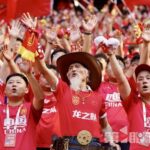Beijing Parks Welcome “National Art Teams”
Crisp flute melodies pierce through the bamboo groves of the park; bright suona notes harmonize with children’s laughter; professional dancers and enthusiasts move together under the bright sun; acrobats who have performed on international stages share diabolo skills with citizens…
Beijing’s parks host several “national art teams” – artists who, though working independently, share the common initiative to step down from grand stages and engage with the public. They not only showcase their exceptional skills but also humbly listen to audience feedback and requests. Scenes of art blending with daily life unfold regularly, creating a mutual journey between artists and their audiences.
Sun Chuting performing at Zizhuyuan Park.
Li Liping participating in a flash performance at Temple of Heaven Park.
Park Artists Become “Internet Sensations”
Recently, videos of a conservatory-trained professional musician performing at Zizhuyuan Park went viral online. In the videos, a graceful young woman with long hair, dressed casually, plays familiar melodies like “Galloping Horses Delivering Grain” and “I Love You, China” while surrounded by enthusiastic crowds. Along with rounds of applause came heartfelt praise from elderly spectators: “She doesn’t put on any airs as an artist, truly embracing the people’s stage,” and “We call her the people’s artist.”
She is Sun Chuting, a bamboo flute and pan flute performer from China National Opera & Dance Drama Theater.
During the National Day holiday, Sun visited parks for the first time to gather material. Hearing about Zizhuyuan Park’s artistic atmosphere, she carried her instrument to a small bamboo grove near the water house. “I was initially a bit socially anxious, but after playing a few pieces, I found myself surrounded by audience members,” Sun recalled. Listeners would shout “Wonderful!” after each piece, and some would eagerly request songs like “Daughter’s Affection.” The overwhelming warmth quickly dissolved her initial nervousness. Sun not only played her signature pieces but also took requests, honestly responding when unfamiliar with a song: “I haven’t mastered this piece yet, but I’ll practice and come back to perform it for you!”
Over the past two months, Sun has performed at Lianhuachi Park and Temple of Heaven Park with folk music enthusiasts, and has been invited to perform at Tianqiao Citizen Square’s open-air concerts, totaling sixteen or seventeen outdoor performances. Citizens and netizens have praised her as “the national team in the park.” Sun admitted, “When I came to Zizhuyuan, I didn’t think of myself as part of any ‘national team’ – I just wanted to make music with everyone.” These park visits represent art returning to the streets, embodying genuine artistic connection with the people.
In Beijing, Sun is not alone. More professional artists are leaving concert halls and conservatories to bring their performances directly to the people. Singer Wei Guangde, who holds concerts at Lianhuachi Park, is affectionately called “the park tenor”; at Zizhuyuan Park, Naze·Dilimulati, a Beijing Dance Academy graduate known online as “Turick,” has gained popularity through dance exchanges with enthusiasts.
“I studied Chinese folk dance, and our teachers often said that the roots of folk dance lie among the people,” Naze explained. While still a student, she was invited by the leader of Zizhuyuan’s Xinjiang Dance Troupe to join their dancing. “After a few dances, the dance team’s uncles and aunts lined up to challenge me – their enthusiasm immediately infected me.” Currently rehearsing and performing outside Beijing, Naze still speaks excitedly about those experiences: “I directly experienced what Chinese folk dance truly means. Dancing with them in the park brought me immense happiness!”
Performers and Audiences Connect Mutually
In parks, the seamless integration of art and community not only fulfills cultural needs but also reflects artists’ sincerity and warmth.
On November 15th, Guangyanggu Urban Forest Park in Xicheng District presented a moving scene. Under the warm sun, Wang Xiangyang, a suona player from Beijing Chinese Orchestra, first attracted children playing in the exercise area with bird-like melodies from “Hundred Birds Worshiping the Phoenix.” Gradually, park visitors, parents with strollers, and nearby pedestrians gathered around.
Seeing the children’s smiling faces, Wang played the melody of “White Dragon Horse, Hooves Pointing West.” A little girl named Tongtong, not yet five, became so excited she started dancing, carefully picking a red flower from the grass and presenting it to Wang while requesting “Happy




